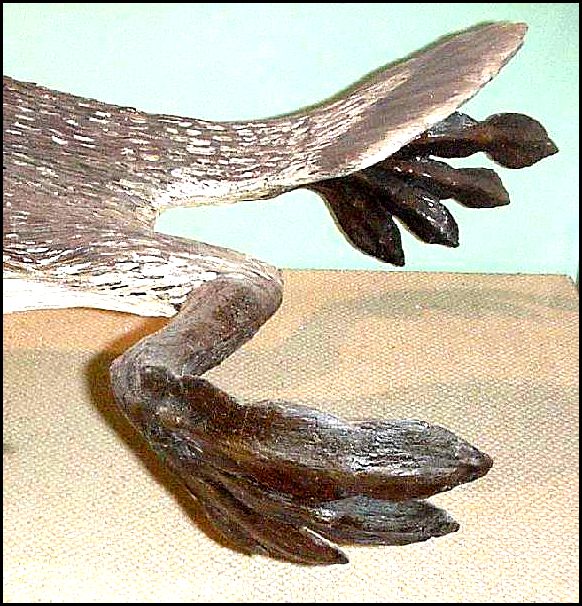On the Dermal
Covering of Hesperornis.
--------------
BY S. W. Williston
--------------
(With Plate II.)
A specimen of Hesperornis, collected in western Kansas the past
year by Mr. H. T. Martin and now in the University Museum, is
of especial interest from the information it affords of the dermal
covering of this Cretaceous toothed bird.
The specimen, which is in
excellent preservation, lies upon a
chalk slab, with the head doubled partially under the pelvis. Some
six or eight vertebrae, together with the humeri and coracoids and
many of the ribs are wanting; otherwise the specimen seems
perfect. The size is distinctly less than that
of H. regalis, and
it does not seem to be due to immaturity. Possibly
the species is
identical with H. gracilis, which has been only
imperfectly de-
scribed.
The photographic
illustration given in Plate II was taken from
the fragment removed from the slab over the right tarso-metatarsal,
the surface of the slab itself being less clearly, though more fully
marked. I have sketched in the bone to
show the relative size and
position
The podotheca is seen to be
scutellate in front. The structure
is shown so clearly in the photography that I need not enter into a
fuller description. The scutes are all smooth,
not imbricated, and
distinctly separated from each other. The are
a little longer from
side to side below, though not much. I
count twenty-six on
the slab, and to the back part of the bone, while impressions of
the feathers will be seen on the opposite side
These feathers were
evidently long, reaching nearly to the
phalangeal articulation, and are clearly
semiplumulaceous in
character, the pennaceous shaft of considerable size, the vanes
long and wavy. The shaft of one feather
is seen in the illustration
lying close to the outline of the bone, and is of considerable size.
I doubt not that the feathers throughout were of this character, or
wholly plumulaceous. I find distinct
impressions of the wavy
vanes at the back of the head and elsewhere, but in no case is
there the impression of a true feather, as I think would surely be
the case had the bird possessed them.
(53 KAN. UNIV. QUAR., VOL V,
NO. 1 JULY 1896, |
54
Kansas University Quarterly,
This plumulaceous character of the plumage is not unexpected.
Although Marsh nowhere mentions the plumage in his work, I
know that he personally had the opinion that it was of a downy
character. That the feathers of the tarsus
should extend to the feet
in a wading bird seems surprising, but there can be no other
interpretation
of the specimen.
|

